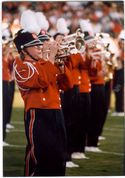 Contrary to our typical desert-dry liturgical image of the season, Lent coincides with spring when the daffodils planted before the winter frost begin to bloom. In some places, spring is the most turbulent time of the year. Winter snows persist and spring storms attack the tender buds of young plants and bare trees. In this hostile environment, calves, lambs and other newborns fight to make it to the gentler days of early summer.
Contrary to our typical desert-dry liturgical image of the season, Lent coincides with spring when the daffodils planted before the winter frost begin to bloom. In some places, spring is the most turbulent time of the year. Winter snows persist and spring storms attack the tender buds of young plants and bare trees. In this hostile environment, calves, lambs and other newborns fight to make it to the gentler days of early summer.
In a similar way, the church’s most vulnerable, the Elect, are fighting their own spring battle. During Lent, the Elect, their godparents and the church community begin an intense discipline to prepare for Easter when the Elect will be baptized.
The church sees itself as a participant in this great springtime drama between life and death, good and evil, between God and the devil. From this perspective, the intense preparation by the Elect and the church is somewhat like the final moments before a great battle, and it may be when both are at their most vulnerable. It is no accident then that Lent takes place in spring.
 For this reason, the sound of Lent cannot be sad, anemic or depressed. We are reminded from the start of the season, “When you fast, do not look gloomy like the hypocrites” (Mt 6:16). The soundtrack to this great drama must be intense. We begin Ash Wednesday with “Blow the trumpet in Zion!” (Jl 2:15), a proclamation to gather the nations. But don’t confuse intense with bombastic or loud. Silence—penetrating stillness that cuts through pretension—is our most fundamental Lenten sound.
For this reason, the sound of Lent cannot be sad, anemic or depressed. We are reminded from the start of the season, “When you fast, do not look gloomy like the hypocrites” (Mt 6:16). The soundtrack to this great drama must be intense. We begin Ash Wednesday with “Blow the trumpet in Zion!” (Jl 2:15), a proclamation to gather the nations. But don’t confuse intense with bombastic or loud. Silence—penetrating stillness that cuts through pretension—is our most fundamental Lenten sound.
Recall too that Lent is not exclusively about Christ’s passion, the cross, the desert or penitence. “Lent is marked by two themes, the baptismal and the penitential….[These two themes] are to be given greater prominence in both the liturgy and liturgical catechesis” (Constitution on the Sacred Liturgy, 109). Use your Easter water music now, adapting the instrumentation and tempo to fit the sobriety of Lent. And save your passion music for Holy Week: “Hymns which emphasize the passion and death of Christ should be used only in the last week of the Lenten season” (Liturgical Music Today, 48).
Take musical risks. Incorporate bold styles and techniques such as blues, gospel, hymnody or a cappella singing. Take music that is usually performed gently and turn them into proclamations by singing them with a bit more force. For example, “Song of the Body of Christ” (David Haas) or “I Know that My Redeemer Lives” (Scott Soper) become fitting statements of baptismal faith when sung at a fuller more intense dynamic.
No comments:
Post a Comment